Abstract
The O2 vibration of dioxygen adducts of Fe and Co model complexes of alpha,alpha,alpha,alpha-tetrapivalamidophenylporphyrin ("picket fence" porphyrin, TpivPP) with 1-methylimidazole and 1-tritylimidazole as axial bases are reported, obtained with difference techniques between 16O2, 18O2, 169-18O, and NO with a Fourier transform infrared spectrometer. Assignments of upsilono2 are (O2)Fe(TpivPP) 1-methylimidazole, 1159 cm-1 in Nujol; (O2)Fe(TpivPP) 1-tritylimidazole, 1163 in benzene; (O2)Co(TpivPP) 1-methylimidazole, 1150 in Nujol; (O2)Co(TpivPP) 1-tritylimidazole, 1153 in benzene. Comparisons with other known Fe, Co, Cr, and Ti dioxygen complexes are made, and it is concluded that the bent dioxygen ligand is best viewed as bound superoxide, O2-. The CO affinities of various hemoproteins and model systems are discussed. A correlation between the CO stretching frequency and its binding constant is described. The drastically lowered affinity of hemoproteins for CO compared with unencumbered models is attributed to steric hindrance in the distal binding site, which allows discrimination between the already bent FeIII-O2- and the normally linear FeII-CO systems. If the affinity of hemoproteins in living systems for CO relative to O2 were not decreased, then massive poisoning would result from endogenous CO.
Full text
PDF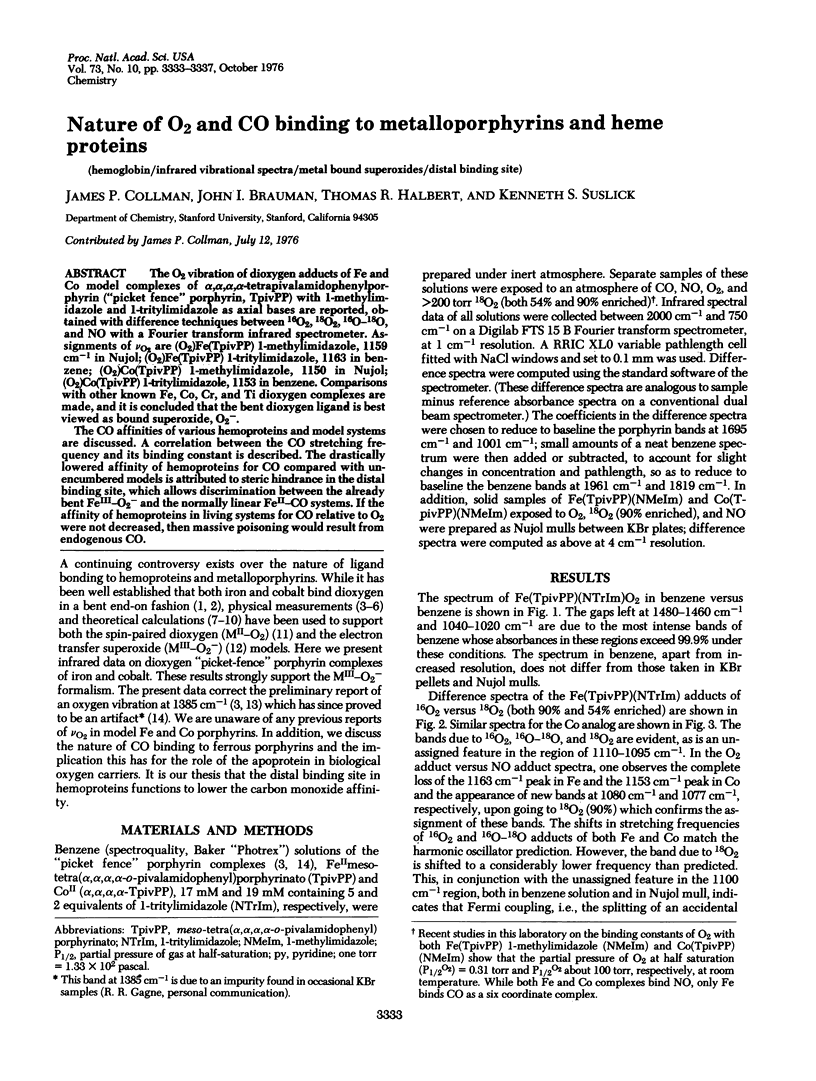
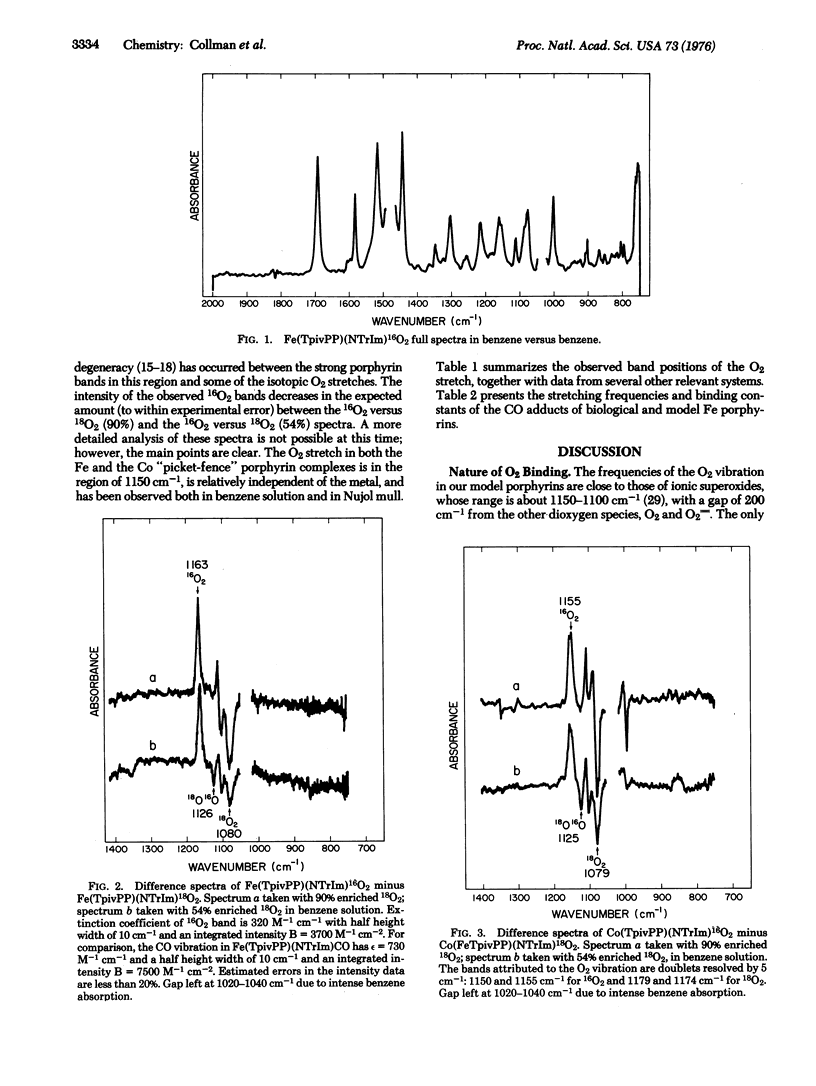
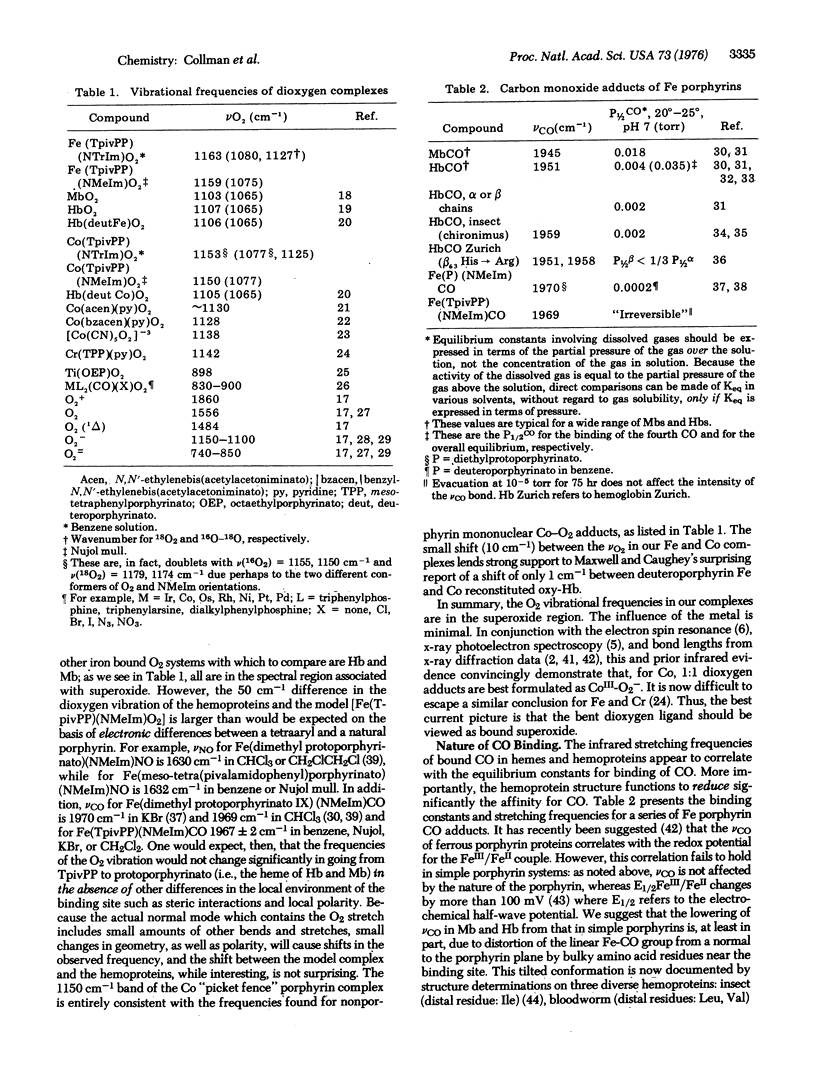
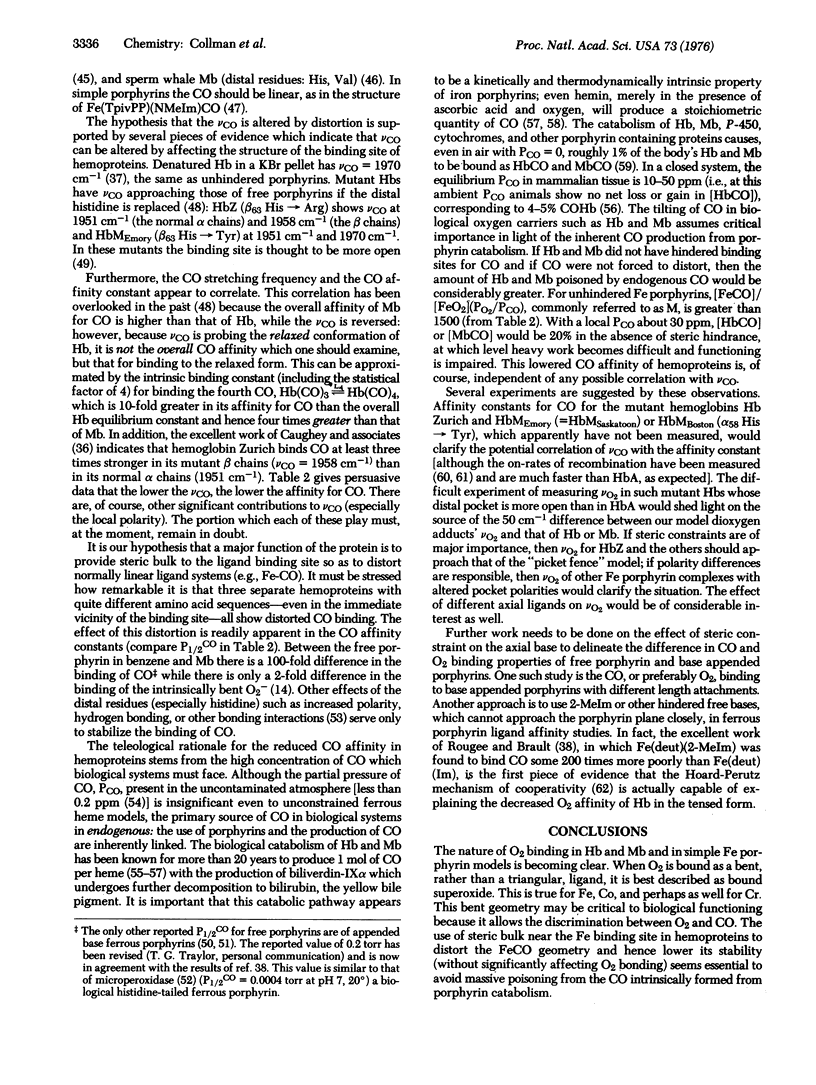
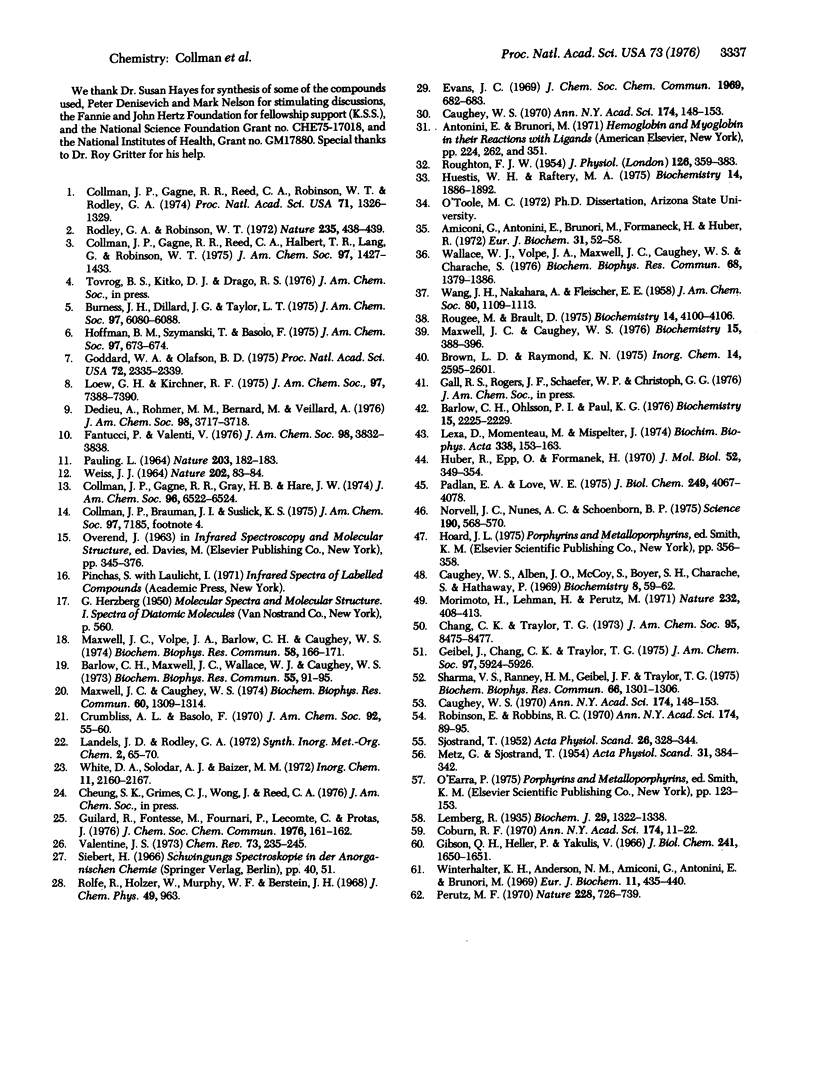
Selected References
These references are in PubMed. This may not be the complete list of references from this article.
- Amiconi G., Antonini E., Brunori M., Formaneck H., Huber R. Functional properties of native and reconstituted hemoglobins from Chironomus thummi thummi. Eur J Biochem. 1972 Nov 21;31(1):52–58. doi: 10.1111/j.1432-1033.1972.tb02499.x. [DOI] [PubMed] [Google Scholar]
- Barlow C. H., Maxwell J. C., Wallace W. J., Caughey W. S. Elucidation of the mode of binding of oxygen to iron in oxyhemoglobin by in frared spectroscopy. Biochem Biophys Res Commun. 1973 Nov 1;55(1):91–96. doi: 10.1016/s0006-291x(73)80063-4. [DOI] [PubMed] [Google Scholar]
- Barlow C. H., Ohlsson P. I., Paul K. G. Infrared spectroscopic studies of carbonyl horseradish peroxidases. Biochemistry. 1976 May 18;15(10):2225–2229. doi: 10.1021/bi00655a031. [DOI] [PubMed] [Google Scholar]
- Caughey W. S. Carbon monoxide bonding in hemeproteins. Ann N Y Acad Sci. 1970 Oct 5;174(1):148–153. doi: 10.1111/j.1749-6632.1970.tb49781.x. [DOI] [PubMed] [Google Scholar]
- Caughey W. S. Carbon monoxide bonding in hemeproteins. Ann N Y Acad Sci. 1970 Oct 5;174(1):148–153. doi: 10.1111/j.1749-6632.1970.tb49781.x. [DOI] [PubMed] [Google Scholar]
- Chang C. K., Traylor T. G. Proximal base influence on the binding of oxygen and carbon monoxide to heme. J Am Chem Soc. 1973 Dec 12;95(25):8477–8479. doi: 10.1021/ja00806a062. [DOI] [PubMed] [Google Scholar]
- Coburn R. F. The carbon monoxide body stores. Ann N Y Acad Sci. 1970 Oct 5;174(1):11–22. doi: 10.1111/j.1749-6632.1970.tb49768.x. [DOI] [PubMed] [Google Scholar]
- Collman J. P., Brauman J. I., Suslick K. S. Letter: Oxygen binding to iron porphyrins. J Am Chem Soc. 1975 Nov 26;97(24):7185–7186. doi: 10.1021/ja00857a050. [DOI] [PubMed] [Google Scholar]
- Collman J. P., Gagne R. R., Reed C. A., Halbert T. R., Lang G., Robinson W. T. "Picket fence porphyrins." Synthetic models for oxygen binding hemoproteins. J Am Chem Soc. 1975 Mar 19;97(6):1427–1439. doi: 10.1021/ja00839a026. [DOI] [PubMed] [Google Scholar]
- Collman J. P., Gagne R. R., Reed C. A., Robinson W. T., Rodley G. A. Structure of an iron(II) dioxygen complex; a model for oxygen carrying hemeproteins. Proc Natl Acad Sci U S A. 1974 Apr;71(4):1326–1329. doi: 10.1073/pnas.71.4.1326. [DOI] [PMC free article] [PubMed] [Google Scholar]
- Coughey W. S., Alben J. O., McCoy S., Boyer S. H., Charache S., Hathaway P. Differences in the infrared stretching frequency of carbon monoxide bound to abnormal hemoglobins. Biochemistry. 1969 Jan;8(1):59–62. doi: 10.1021/bi00829a009. [DOI] [PubMed] [Google Scholar]
- Dedieu A., Rohmer M. M., Benard M., Veillard A. Letter: Oxygen binding to iron porphyrins. An ab initio calculation. J Am Chem Soc. 1976 Jun 9;98(12):3717–3718. doi: 10.1021/ja00428a060. [DOI] [PubMed] [Google Scholar]
- Geibel J., Chang C. K., Traylor T. G. Letter: Coordination of myoglobin active site models in aqueous solution as studied by kinetic methods. J Am Chem Soc. 1975 Oct 1;97(20):5924–5926. doi: 10.1021/ja00853a053. [DOI] [PubMed] [Google Scholar]
- Gibson Q. H., Heller P., Yakulis V. The rate of reaction of carbon monoxide with hemoglobins M. J Biol Chem. 1966 Apr 10;241(7):1650–1651. [PubMed] [Google Scholar]
- Goddard W. A., 3rd, Olafson B. D. Ozone model for bonding of an O2 to heme in oxyhemoglobin. Proc Natl Acad Sci U S A. 1975 Jun;72(6):2335–2339. doi: 10.1073/pnas.72.6.2335. [DOI] [PMC free article] [PubMed] [Google Scholar]
- Huber R., Epp O., Formanek H. Structures of deoxy- and carbonmonoxy-erythrocruorin. J Mol Biol. 1970 Sep 14;52(2):349–354. doi: 10.1016/0022-2836(70)90035-5. [DOI] [PubMed] [Google Scholar]
- Huestis W. H., Raftery M. A. Conformation and cooperativity in hemoglobin. Biochemistry. 1975 May 6;14(9):1886–1892. doi: 10.1021/bi00680a013. [DOI] [PubMed] [Google Scholar]
- Lemberg R. Transformation of haemins into bile pigments. Biochem J. 1935 Jun;29(6):1322–1336. doi: 10.1042/bj0291322. [DOI] [PMC free article] [PubMed] [Google Scholar]
- Loew G. H., Kirchner R. F. Letter: Electronic structure and electric field gradients in oxyhemoglobin and -cytochrome P-450 model compounds. J Am Chem Soc. 1975 Dec 10;97(25):7388–7390. doi: 10.1021/ja00858a037. [DOI] [PubMed] [Google Scholar]
- METZ G., SJOSTRAND T. Formation and elimination of CO in mammals. Acta Physiol Scand. 1954 Aug 20;31(4):384–392. doi: 10.1111/j.1748-1716.1954.tb01149.x. [DOI] [PubMed] [Google Scholar]
- Maxwell J. C., Caughey W. S. An infrared study of NO bonding to heme B and hemoglobin A. Evidence for inositol hexaphosphate induced cleavage of proximal histidine to iron bonds. Biochemistry. 1976 Jan 27;15(2):388–396. doi: 10.1021/bi00647a023. [DOI] [PubMed] [Google Scholar]
- Maxwell J. C., Caughey W. S. Infrared evidence for similar metal-dioxygen bonding in iron and cobalt oxyhemoglobins. Biochem Biophys Res Commun. 1974 Oct 23;60(4):1309–1314. doi: 10.1016/0006-291x(74)90340-4. [DOI] [PubMed] [Google Scholar]
- Maxwell J. C., Volpe J. A., Barlow C. H., Caughey W. S. Infrared evidence for the mode of binding of oxygen to iron of myoglobin from heart muscle. Biochem Biophys Res Commun. 1974 May 7;58(1):166–171. doi: 10.1016/0006-291x(74)90906-1. [DOI] [PubMed] [Google Scholar]
- Morimoto H., Lehmann H., Perutz M. F. Moleuclar pathology of human haemoglobin: stereochemical interpretation of abnormal oxygen affinities. Nature. 1971 Aug 6;232(5310):408–413. doi: 10.1038/232408a0. [DOI] [PubMed] [Google Scholar]
- Norvell J. C., Nunes A. C., Schoenborn B. P. Neutron diffraction analysis of myoglobin: structure of the carbon monoxide derivative. Science. 1975 Nov 7;190(4214):568–570. doi: 10.1126/science.1188354. [DOI] [PubMed] [Google Scholar]
- Padlan E. A., Love W. E. Three-dimensional structure of hemoglobin from the polychaete annelid, Glycera dibranchiata, at 2.5 A resolution. J Biol Chem. 1974 Jul 10;249(13):4067–4078. [PubMed] [Google Scholar]
- Perutz M. F. Stereochemistry of cooperative effects in haemoglobin. Nature. 1970 Nov 21;228(5273):726–739. doi: 10.1038/228726a0. [DOI] [PubMed] [Google Scholar]
- ROUGHTON F. J. The equilibrium between carbon monoxide and sheep haemoglobin at very high percentage saturations. J Physiol. 1954 Nov 29;126(2):359–383. doi: 10.1113/jphysiol.1954.sp005215. [DOI] [PMC free article] [PubMed] [Google Scholar]
- Robinson E., Robbins R. C. Atmospheric background concentrations of carbon monoxide. Ann N Y Acad Sci. 1970 Oct 5;174(1):89–95. doi: 10.1111/j.1749-6632.1970.tb49775.x. [DOI] [PubMed] [Google Scholar]
- Rodley G. A., Robinson W. T. Structure of a monomeric oxygen-carrying complex. Nature. 1972 Feb 25;235(5339):438–439. doi: 10.1038/235438a0. [DOI] [PubMed] [Google Scholar]
- SJOSTRAND T. The formation of carbon monoxide by in vitro decomposition of haemoglobin in bile pigments. Acta Physiol Scand. 1952;26(4):328–333. doi: 10.1111/j.1748-1716.1952.tb00913.x. [DOI] [PubMed] [Google Scholar]
- Sharma V. S., Ranney H. M., Geibel J. F., Traylor T. G. A new method for the determination of ligand dissociation rate constant of carboxyhemoglobin. Biochem Biophys Res Commun. 1975 Oct 27;66(4):1301–1306. doi: 10.1016/0006-291x(75)90501-x. [DOI] [PubMed] [Google Scholar]
- WEISS J. J. NATURE OF THE IRON-OXYGEN BOND IN OXYHAEMOGLOBIN. Nature. 1964 Apr 4;202:83–84. doi: 10.1038/202083b0. [DOI] [PubMed] [Google Scholar]
- WEISS J. J. NATURE OF THE IRON-OXYGEN BOND IN OXYHAEMOGLOBIN. Nature. 1964 Jul 11;203:182–183. [PubMed] [Google Scholar]
- Wallace W. J., Volpe J. A., Maxwell J. C., Caughey W. S. Properties of hemoglobin A and hemoglobin Zurich (beta63 histidine replaced by arginine): quantitative evaluation of functional abnormalities in hemoglobins. Biochem Biophys Res Commun. 1976 Feb 23;68(4):1379–1386. doi: 10.1016/0006-291x(76)90348-x. [DOI] [PubMed] [Google Scholar]
- Winterhalter K. H., Anderson N. M., Amiconi G., Antonini E., Brunori M. Functional properties of hemoglobin Zürich. Eur J Biochem. 1969 Dec;11(3):435–440. doi: 10.1111/j.1432-1033.1969.tb00793.x. [DOI] [PubMed] [Google Scholar]


